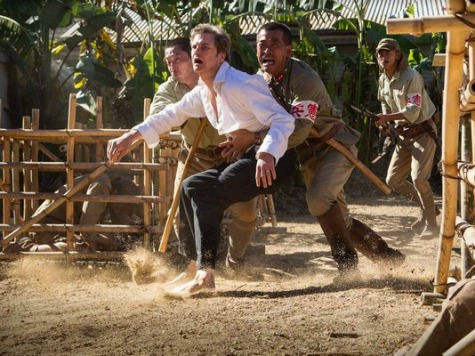Harvey Weinstein, who never misses a chance to genuflect at the altar of President Barack Obama, is releasing a film Friday centering on waterboarding to remind Americans just how inhumane the Bush Administration was.
The Railway Man, based on the book of the same name, focuses on the real-life story of Eric Lomax, a World War II British soldier who was tortured by the Japanese when they discovered he had built a clandestine radio.
Obama outlawed waterboarding in 2009, despite evidence the Bush Administration had gained valuable information about terrorist plots from using the technique, and the Obama Administration used information gleaned from waterboarding to hunt down Osama Bin Laden.
Australian director Jonathan Teplitzky is blunt about his desire to slam the interrogation technique, saying he “absolutely” and “without a doubt” wants to make waterboarding a hot issue. He told the Hollywood Reporter:
The first thing that struck me is that it happened to Eric in 1943 and yet it is still very much a practice today. It’s so indescribable to watch it being filmed, let alone to think that some human beings went through that. I thought it was important that the film embrace that … Look, you try very hard not to set out to make simply a message film, but in a story like this you’re dealing with incredibly big and important things … This kind of maltreatment has incredible resonance for contemporary times. I mean, it’s not even called ‘torture’ anymore — it’s called ‘enhanced interrogation’…. Interestingly enough, the Nazis called it ‘enhanced interrogation.’ Waterboarding has a very strong tentacle to the modern day, and we were very conscious of that.
The 1940s Lomax is played by Jeremy Irvine: Nicole Kidman plays his wife; Colin Firth plays the soldier 40 years later, when he finds one of the Japanese who tortured him is alive and heading a museum in precisely the same spot as where Lomax was tortured.
Teplinsky continued:
We researched it a great deal and wanted to replicate what Eric had been through. But obviously we did it in a very safe way. It’s bizarre talking about it, but what’s great about film is that you can piece it together in small bits. In rehearsal — which we did a great deal of — we tried different things and Jeremy felt he could do it for about eight seconds, but we only did it for about four seconds each time, and we controlled the water so the actor was safe. He had water in his mouth but waterboarding is about forcing water into the lungs, and obviously we weren’t doing that.
The director added:
My personal view on waterboarding, as it is with most institutionalized violence, is that it’s pretty abhorrent. I struggle greatly with the idea that a justification for torture is that it will give us a safer world … Yes, the movie is set 50 years ago, but in some part it’s very much a story for our time…. It’s not about Americans per se, it’s about what we’re capable of doing to each other as human beings. That’s why I wanted to make this film, because it was a very succinct story about the very best and worst of what humans are capable of. Revenge and forgiveness are two fundamental emotions that define us as human beings. I wasn’t interested in pointing a finger at Americans or anyone else — I’m Australian and we very much sided with America through these last wars — it’s more about asking, “Is this how we need to behave?”

COMMENTS
Please let us know if you're having issues with commenting.